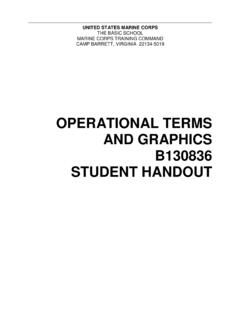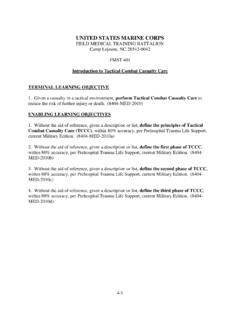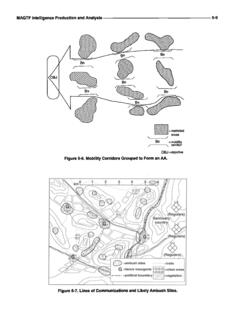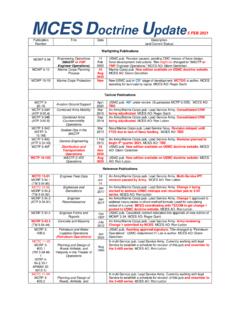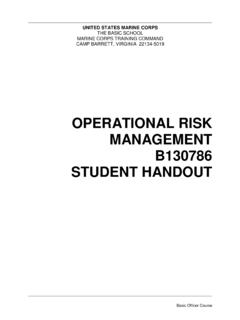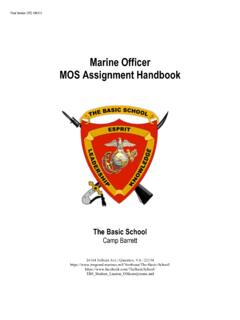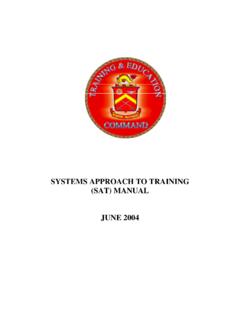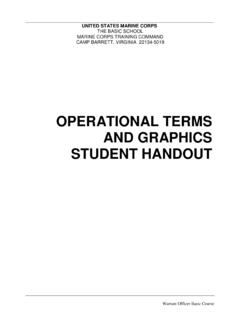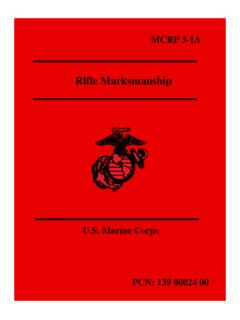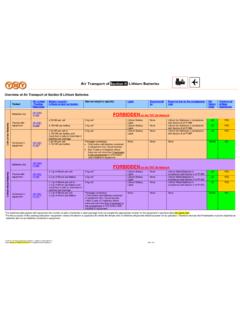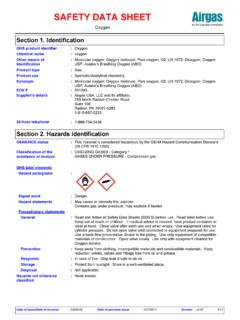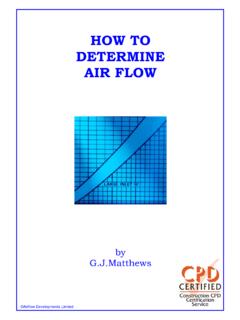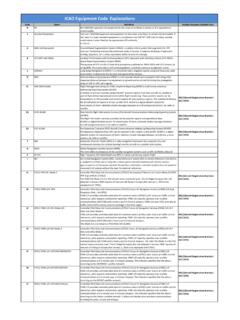Transcription of CLOSE AIR SUPPORT - United States Marine Corps
1 MCWP CLOSE AIR SUPPORT Marine Corps PCN 143 000055 00 DEPARTMENT OF THE NAVYH eadquarters United States Marine CorpsWashington, DC 20380-177530 July 1998 FOREWORDC lose air SUPPORT (CAS) is a Marine Corps innovation. Since thefirst dive bombing attempts in World War I and subsequentoperations in Haiti, the Dominican Republic, and Nicaragua in the1920s, Marines have realized the value of closely integratingaviation with ground combat efforts. World War II and the Koreanwar galvanized the importance of CAS. During those conflicts, thefundamental tactics, techniques, and procedures (TTP) forconducting CAS today were forged in places such as Guadalcanaland the Pusan Perimeter.
2 Today, CAS continues to be Marineaviation s unique contribution to the combat power available to aMarine air-ground task force (MAGTF) Corps Warfighting Publication (MCWP) , CLOSE AirSupport, addresses basic CAS doctrine and TTP. MCWP and expands on the information in MCWP 3-23, Of-fensive Air SUPPORT , by focusing on the details of CAS employmentand the role CAS plays in integrated MAGTF, joint, and multina-tional operations. Designated for MAGTF commanders, naval ex-peditionary force commanders, joint force commanders, and theirstaffs, MCWP highlights CAS:FundamentalsCommand, control, and communicationsPlanning considerationsExecution using fixed- and rotary-wing provides the requisite information needed bycommanders and staffs to understand and evaluate the capabilitiesof various CAS employment options.
3 Additionally, MCWP standard procedures and terminology by which ground forcepersonnel and pilots of fixed- and rotary-wing aircraft can deliveraircraft ordnance in CLOSE proximity to friendly forces. This publication supersedes Fleet Marine Force Manual (FMFM)5-41, CLOSE Air SUPPORT and CLOSE -in Fire for improving this publication are invited fromcommands as well as directly from individuals. Reviewed and approved this DIRECTION OF THE COMMANDANT OF THE Marine Corps J. E. RHODES Lieutenant General, Marine Corps Commanding GeneralMarine Corps Combat Development CommandDISTRIBUTION: 143 000055 00 CLOSE AIR SUPPORTT able Of Contents PageChapter Utility1-4 CLOSE Air SUPPORT Integration1-5 CLOSE Air SUPPORT Employment1-5 Threat Levels1-7 Conditions for Effective CLOSE Air Support1-8 Chapter , Control, andCommunicationsAmphibious Tactical Air Control System 2-1 Navy Tactical Air Control System 2-3 Marine Air Command and Control System2-4 Communications2-10 CLOSE Air SUPPORT Command and Controlfor Joint Force Operations2-15 Chapter I.
4 Basic ConsiderationsClose Air SUPPORT Employment Planning3-1 CLOSE Air SUPPORT Mission Planning3-6 CLOSE Air SUPPORT Navigation Planning3-11 CLOSE Air SUPPORT Logistic Planning3-13 Section II. Control and Coordination MeasuresAirspace Control Measures3-16 Fire SUPPORT Coordination Measures3-26 Integrating CLOSE Air SUPPORT with Other Fires3-30 Coordinated Operations3-42 Section III. Requesting and TaskingMAGTF Commander s Guidance3-43 CLOSE Air SUPPORT Requests3-43 CLOSE Air SUPPORT Requests Afloat3-48 Joint CLOSE Air SUPPORT Request Procedures3-49 Request Format3-51 Mission Data3-51 Section IV. Night/Adverse Weather CLOSE Air SUPPORT PlanningBasic Considerations3-52 Aircraft Munitions and equipment Selection3-53 Visual Employment3-55 System-Aided Employment3-56 Night Vision Device Employment3-57 Target Identifiers3-60 Chapter 4.
5 ExecutionSection I. Basic ConsiderationsSynchronized Timing4-1 Security4-2 Check-In4-2 CLOSE Air SUPPORT Briefing Form4-2 Risk-Estimate Distance4-7 Target Marking4-8 Final Attack Control4-13 Abort Procedures4-18 Battle Damage Assessment4-19 Section II. Night/Limited-VisibilityClose Air SupportVisual Employment4-22 System-Aided Employment4-22 Night Vision Goggle Employment4-23 Section III. CLOSE Air SUPPORT Execution withLaser-Guided SystemsBasic Requirements4-25 Laser-Guided Weapons4-26 Laser Target Designators4-27 Laser Spot Trackers4-28 Laser Procedures4-28 Section IV. Fixed-Wing ExecutionLaunch and Departure Procedures4-34En Route Tactics (Before the Contact Point)4-34 Ingress Tactics (Contact Point to Initial Point)4-38 Attack Phase (Initial Point to Target)4-41 Fixed-Wing Laser-Guided System Employment4-48 Egress4-51 Section V.
6 Rotary-Wing ExecutionLaunch and Departure Procedures (Takeoff toRendezvous Point)4-53En Route Tactics (Rendezvous Point to Holding Area)4-53 Ingress Tactics (Holding Area to Battle Position)4-55 Attack Phase (Within the Battle Point)4-58 Disengagement and Egress4-61 Rotary-Wing Laser-Guided Systems Employment4-62 Section VI. Return-to-ForceProcedures4-67 Debriefing4-68 AppendicesAClose Air SUPPORT Aircrew Mission Planning GuideA-1 BPlanning Considerations for CLOSE Air SupportUsing Night Vision Goggles and Infrared PointersB-1 CAircraft Weapons and Capabilities GuideC-1 DJoint Tactical Airstrike Request D-1 ECommunications EquipmentE-1 FRisk-Estimate DistancesF-1 GNATO CLOSE Air SUPPORT FormatsG-1 HAC-130 CLOSE Air SUPPORT EmploymentH-1 IGlossaryI-1 JReferences and Related PublicationsJ-1(reverse blank)
7 Chapter 1 FundamentalsINTRODUCTIONCAS is an air action by fixed- and rotary-wing aircraft againsthostile targets which are in CLOSE proximity to friendly forces andwhich require detailed integration of each air mission with the fireand movement of those forces. (Joint Publication (Joint Pub) 1-02,DOD Dictionary of Military and Associated Terms)CAS is an offensive air SUPPORT (OAS) mission that is planned andexecuted to deliver firepower against selected enemy capabilities ata designated place and time. By using the speed and mobility of air-craft, CAS provides the commander with the means to strike the en-emy swiftly and unexpectedly. Applying the fundamentals ofcombined arms, the commander integrates CAS with other forms offire SUPPORT and the fire and movement of ground forces.
8 In so do-ing, the commander takes advantage of fleeting battlefield opportu-nities and achieves combat objectives. CAS is a mission conductedat the tactical level that may affect operational-level is conducted when and where friendly combat forces are inclose proximity to enemy forces. The word CLOSE does not imply aspecific distance; rather, it is situational. The requirement for de-tailed integration based on proximity, fires, or movement is the de-termining factor. CAS provides firepower to neutralize, destroy, ordelay enemy forces in offensive and defensive times, CAS is the best firepower delivery means available to rap-idly mass a lethal capability, exploit tactical opportunities, or savefriendly lives.
9 Available aircraft that are capable of performingCAS are fully integrated into ground operations, thereby giving thecommander flexibility in force employment. The effectiveness ofCAS is proportional to the degree to which it is integrated into theplanning and conduct of MAGTF operations. The supported unitcommander influences the use of CAS by requesting and approvingall CAS missions within his area of MAGTF commander uses CAS to concentrate firepower on theenemy. CAS provides fire SUPPORT with the speed and violence thatis essential in maneuver warfare. The MAGTF commander uses thefollowing criteria to determine CAS employment:The MAGTF s mission and concept of operationsThe MAGTF s ability to counter enemy air defensesThe availability of, and compatibility with, other and timely communication and control are necessary if CASis to be successful.
10 To deliver effective CAS, an aircrew must:Be responsiveRemain flexibleBe familiar with the supported unit s scheme of maneuver andunderstand the MAGTF commander s intentAcquire the correct targetPlace the appropriate type of ordnance accurately on the target. 1 - 2 MCWP the concept is simple, CAS requires detailed planning, co-ordination, and training for effective and safe execution. FRATRICIDEF ratricide, or casualties to friendly forces caused by friendly fire, isan undesirable and avoidable circumstance in warfare. All of theTTP outlined throughout this publication are designed to avoid frat-ricide while maximizing the effectiveness of Although it is occasionally the result of a malfunction-ing weapon, fratricide is often the result of uncertainty on thebattlefield.
